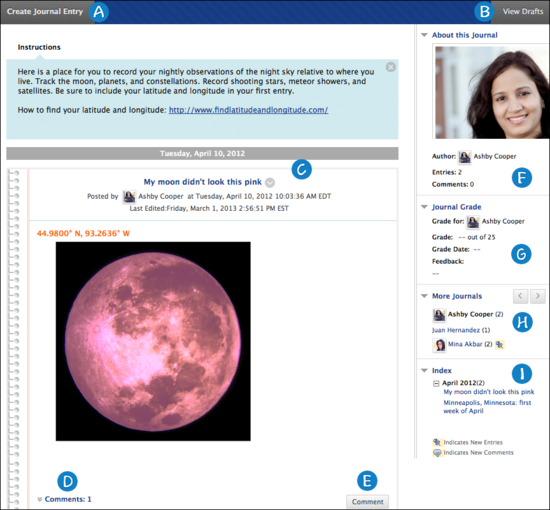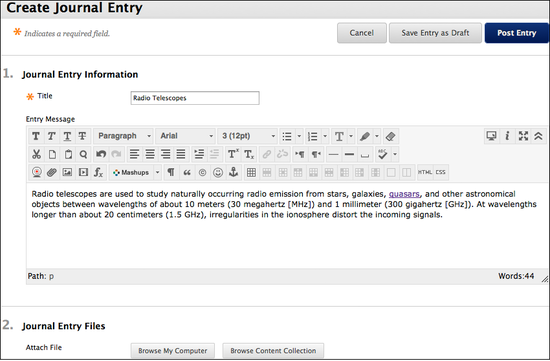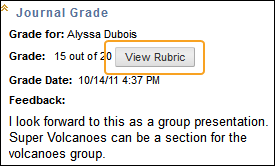- WTClass Student Help Home
- Login Help
- Assignments
- Tests and Quizzes
- My Grades
- Community Tools
- Media
- Other
- Technical Help
- Technology Support Portal
![]()
Community Tools
Community Tools
On This Page
Journals
Journals are a personal space for you to communicate privately with your instructor. You can also use a journal as a self-reflective tool to post your opinions, ideas, and concerns about your course, or discuss and analyze course related materials. For example, you can describe problems you faced and how you solved them. Your instructor can direct journal entries to be more formal in nature and narrower in focus by listing topics for discussion.
Your instructor can choose to make journal entries public, allowing all course members to view all entries. You can read what other students wrote and build on those ideas.
When used in the group area, members of a group can view and comment on each other’s entries for a group journal. The group can communicate with their instructor as a whole and all members can benefit from the comments made.
Your instructor can grade group journals and apply the grade to every member of the course group. Journal entries can also be used specifically for communication. In either instance, you can make multiple entries for one journal topic.
The journal topic page is divided into two main sections. You can view the instructions in the content frame. Click the X to collapse the instructions. In the side panel, you can view information about the journal. Expand and collapse sections in the side panel using the arrow next to a title.

- Create Journal Entry: Create a journal entry using the Create Journal Entry function. You can make another journal entry for a topic at any time. For example, your instructor may add a comment requesting that you clarify what has been written before a grade is assigned or suggest a topic for another entry.
- View Drafts: Access any entries saved as drafts. Click View Drafts on the action bar.
- Journal Entry: Your journal entries appear in the content frame following the Instructions.
- Comments: Following an entry, you can see if comments were made. Click the link to view comments.
- Comment: You can add comments by clicking Comment.
- About this Journal: In the side panel, view the journal information in the About this Journal section. By default, About this Journal is collapsed. You must expand it to view the information.
- Journal Grade: The Journal Grade section appears if a journal is set to be graded. You can see if your journal entries have been graded.
- More Journals: View other journal entries made by other course members in the More Journals section.
- Index: View the titles of your selected entries for either the week or the month in the Index section, determined by the settings your instructor selects during journal creation. The most recent entry title appears first.
How to Access a Journal
- On the course menu, click Tools and select Journals.
- On the Journals listing page, click the journal title you want to access.
- The journal listing page appears.
How to Create a Journal Entry
Only your instructor can create a journal topic, but after creation, you can create entries. The journal topics appear in alphabetical order on the journals listing page. Create and post journal entries or save them in draft form for later posting.
- On the course menu, click Tools and select Journals.
- On the Journals listing page, select a journal to open.
- On the journal topic page, click Create Journal Entry.
- On the Create Journal Entry page, type an Entry Title.
- Type the text in the Entry Message text box.
- Optionally, in the Journal Entry Files section, attach a file using one of the following options:
- To upload a file from your computer, click Browse My Computer.
- To upload a file from the course's storage repository, click Browse Content Collection.
Files added by students will appear with the entry, but are not stored in the Content Collection.
- Click Post Entry
-OR-
Click Save Entry as Draft to save the entry for later posting.

If your instructor has associated a rubric with the journal and made it available to students, click View Rubric in the Journal Grade section to display grading criteria. If there is no associated rubric or your instructor has not made it available, the View Rubric button will not be visible.
Viewing Journal Drafts
You can save journal entries to post later by clicking Save Entry as Draft. You can view these drafts by clicking View Drafts on the main journal page.
How to Comment on a Journal Entry
You can create comments to journal entries if commenting is allowed by your instructor. You can add a comment after your instructor comments on an entry to continue the conversation.
You cannot make comments on another user’s journal entry, even if the journal has been made public. Users can only comment on another user’s entry when they are members of a group. For group journals, all group members and their instructor are allowed to make comments on individual entries.
- On the course menu, click Tools and select Journals.
- On the Journals listing page, select a journal to open.
- On the Journal topic page, click Comment for the selected entry.
- Type a comment in the Comment box.
- Click Add.
How to Edit a Journal Entry
You can edit your journal entries if your instructor allows it. However, if you edit gradable journal entries, the original graded entry will be lost.
- On the course menu, click Tools and select Journals.
- On the Journals listing page, select a journal to open.
- On the journal topic page, select Edit from the contextual menu for the journal entry.
- On the Edit Journal Entry page, make the necessary changes.
- Click Post Entry.
Viewing Journal Grades
When your journal entries have been graded, you can view your grade in two places. The grading information appears under the Journal Grade section on the Journal topic page and in the My Grades tool. Any feedback and the date the grade was assigned also appear in these areas.

If your instructor has used a rubric for grading and made it available to students, click View Rubric to display detailed grading information.

If there is no associated rubric or your instructor has not made it available, the View Rubric button will not be visible.